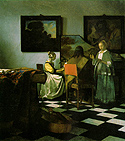
First Person: Geoffrey Kelly
On March 18 1990 I was visiting New York’s Museum of Natural History when I overheard someone say that thieves at the Isabella Stewart Gardner Museum in Boston had just got away with the biggest art heist in history – half a billion dollars worth. I’d recently graduated from film school at Boston University, yet I’d never heard of the museum. I worked in the television industry and could never have predicted that eventually I’d spend eight years leading the FBI’s hunt to recover the artwork.
The heist was pulled off by two men who posed as police officers, tied up the museum guards with duct tape, and spent 81 minutes stealing 13 works of art. There are only 36 Vermeers in existence, and the one they stole, “The Concert”, is the only one that’s not accounted for. Their haul also included a Manet and three Rembrandts, one of which, “Storm on the Sea of Galilee”, was his only known seascape.
Although I went into television, I’d always wanted to be an FBI agent. I became a transit cop in New York and then joined the FBI. Eight years ago, I was on the organisation’s Violent Crime Squad, which is the squad that was working on the heist investigation, and the case was assigned to me. I had no experience working in this area, so there was a lot of on-the-job training with the FBI’s art crime team. We spoke to curators, restorers, specialists from auction houses and other art theft investigators. That doesn’t mean to say that we’re all art experts, but it helps us understand how the art black market works, and now I’m the FBI’s art theft co-ordinator. As for my own taste in art, maybe I’m biased from this case, but I’ve always liked the Dutch Masters.
After eight years, it would be difficult for me to not have my own theories on who stole the art. But one of the hardest things about being the lead investigator on a case of this magnitude is that while I have my own ideas, I have to be open-minded. I have to investigate all theories, and leads come in all the time. Sometimes the leads are obscure or ambiguous, where somebody calls up and says this guy they know looks like one of the subjects in the sketches. Then there are the ones where people have psychic visions. Once somebody said they had devised a scientific instrument that they believed could locate the paintings. In 2005, we had a tip that some of the artwork was in Paris so we went over and ran everything down to the ground. We got back in touch with Paris after the art heist there in May at the Museum of Modern Art, when $123m worth of art was stolen, but there didn’t seem to be any connections.
According to Isabella Stewart Gardner’s will, nothing can be added or removed from the collection, so the empty frames are still on the museum walls. The museum is offering a $5m reward, and the US Attorney’s office is willing to offer immunity in return for the paintings. I’m very optimistic that the artwork will come back – it’s just a question of when. In 1978, a Rembrandt was stolen from San Francisco’s de Young Museum and it was recovered 20 years later. People steal artwork and then sit on it, thinking that it’s going to stop being so hot. Unfortunately for the Boston thieves, they carried out the largest art heist in the world, so those paintings are always going to be hot.
Art Hostage Comments:
Comments to follow..............

No comments:
Post a Comment